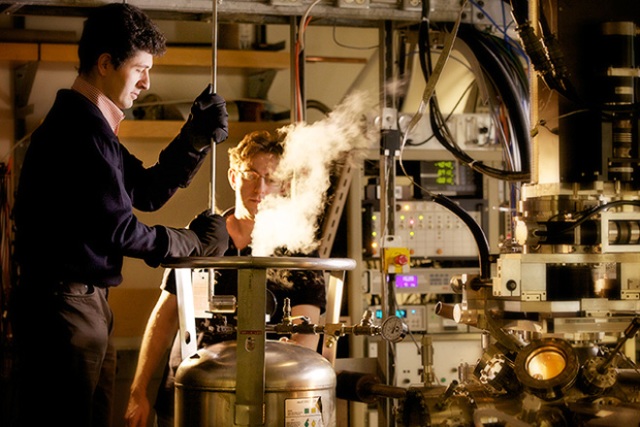Jun 2 2015
Physicists have painted an in-depth portrait of charge ordering—an electron self-organization regime in high-temperature superconductors that may be intrinsically intertwined with superconductivity itself.
 University of British Columbia physicists Andrea Damascelli, left, and Giorgio Levy, working with liquid helium.
University of British Columbia physicists Andrea Damascelli, left, and Giorgio Levy, working with liquid helium.
In two complementary studies—published in Nature Materials last week and Science in March—University of British Columbia researchers confirm that charge ordering forms a predominantly one dimensional ‘d-wave pattern’.
“Everything we can learn about the structure of charge ordering gets us a step closer to understanding how it’s intertwined with, and potentially competes with, superconductivity,” says Riccardo Comin, lead author of both papers who conducted the research while a PhD student at UBC. Comin is now a post-doctoral fellow at the University of Toronto.
Charge ordering creates instabilities in cuprate superconductors at temperatures warmer than -100 degrees Celsius. It causes some electrons to reorganize into new periodic static patterns that compete with superconductivity. The reason behind this competition has remained elusive until these studies demonstrated that charge ordering and superconductivity share the same underlying symmetry.
“Intriguingly, superconducting pairs of electrons also exhibit a so-called d-wave configuration,” says UBC physicist Andrea Damascelli, leader of the research team and senior fellow with the Canadian Institute for Advanced Research’s Quantum Materials Program. “So this gives more credence to the possibility that both phenomena are siblings feeding off an underlying common interaction.”
In March’s Science paper, Comin, Damascelli and colleagues investigated cold samples of yttrium barium copper oxide using x-rays and discovered that charge ordering produces a striped pattern, meaning the electrons self-organize along one direction rather than in two directions.
The two studies were possible thanks to the longstanding collaboration between UBC and the REIXS beamline at the Canadian Light Source, where all the x-ray experiments were performed.
“Combined,” says Comin, “our recent investigations provide a complete resolution of the symmetry of the charge order in cuprates.”